
GK Persei was a bright nova first observed on Earth in 1901. It was discovered by Thomas David Anderson, an Edinburgh clergyman, at 02:40 UT on 22 February 1901 when it was at magnitude 2.7. It reached a maximum magnitude of 0.2, the brightest nova of modern times until Nova Aquilae 1918. After fading into obscurity at about magnitude 12 to 13 during the early 20th century, GK Persei began displaying infrequent outbursts of 2 to 3 magnitudes. Since about 1980, these outbursts have become quite regular, typically lasting about two months and occurring about every three years. Thus, GK Persei seems to have changed from a classical nova like Nova Aquilae 1918 to something resembling a typical dwarf nova-type cataclysmic variable star.
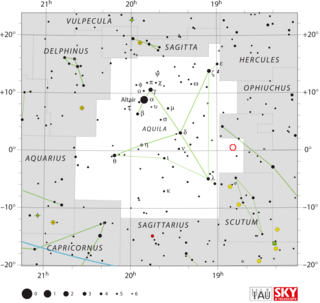
V603 Aquilae was a bright nova first observed in the constellation Aquila in 1918. It was the brightest "new star" to appear in the sky since Kepler's Supernova in 1604. Like all novae, it is a binary system, comprising a white dwarf and donor low-mass star in close orbit to the point of being only semidetached. The white dwarf sucks matter off its companion, which has filled its Roche lobe, onto its accretion disk and surface until the excess material is blown off in a thermonuclear event. This material then forms an expanding shell, which eventually thins out and disappears.
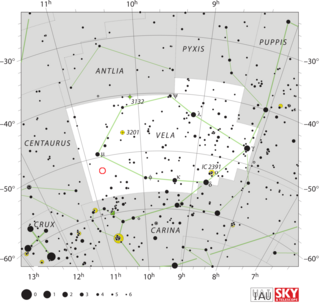
V382 Velorum, also known as Nova Velorum 1999, was a bright nova which occurred in 1999 in the southern constellation Vela. V382 Velorum reached a brightness of 2.6 magnitude, making it easily visible to the naked eye. It was discovered by Peter Williams of Heathcote, New South Wales, Australia at 09:30 UT on 22 May 1999. Later that same day it was discovered independently at 10:49 UT by Alan C. Gilmore at Mount John University Observatory in New Zealand.

T Aurigae was a nova, which lit up in the constellation Auriga in 1891. Thomas David Anderson, an amateur astronomer in Edinburgh, reported that he was "almost certain" he saw the nova at 02:00 UT on 24 January 1892, when it was slightly brighter than χ Aurigae. He mistook the star for 26 Aurigae, although he noted to himself that it seemed brighter than he remembered it being. He saw it twice more during the following week. On 31 January 1892 he realized his mistake, and wrote a note to Ralph Copeland reporting his discovery. Professor Copeland immediately reported the discovery via telegram to William Huggins, who made the first spectroscopic observations of T Aurigae on 2 February 1892, when the star was a magnitude 4.5 object. T Aurigae was the first nova to be observed spectroscopically.
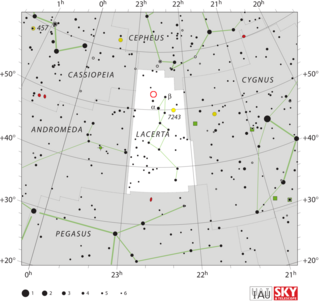
DI Lacertae or Nova Lacertae 1910 was a nova in constellation Lacerta which appeared in 1910. It was discovered by Thomas Henry Espinell Compton Espin at Wolsingham Observatory on 30 Dec 1910, at which time it was an 8th magnitude object. Subsequent examination of pre-discovery photographic plates showed that the outburst occurred sometime between 17 November 1910 and 23 November 1910. It reached a peak brightness of magnitude 4.6 on 26 November 1910, making it visible to the naked eye. Before the nova event DI Lacertae was a 14th magnitude star, and by 1950 it had returned to 14th magnitude.
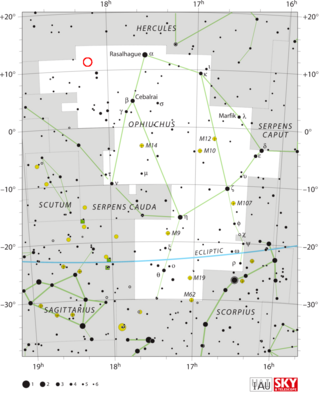
V849 Ophiuchi or Nova Ophiuchi 1919 was a nova that erupted in 1919, in the constellation Ophiuchus, and reached a blue band brightness of magnitude 7.2. Joanna C. S. Mackie discovered the star while she was examining Harvard College Observatory photographic plates. The earliest plate it was visible on was exposed on August 20, 1919, when the star was at magnitude 9.4. It reached magnitude 7.5 on September 13 of that year. In its quiescent state it has a visual magnitude of about 18.8. V849 Ophiuchi is classified as a "slow nova"; it took six months for it to fade by three magnitudes.

V533 Herculis was a nova visible to the naked eye, which occurred in 1963 in the constellation of Hercules.

NQ Vulpeculae also known as Nova Vulpeculae 1976, was a nova that appeared in the constellation Vulpecula in 1976. It was discovered visually at 18:20 UT on October 21, 1976 by English amateur astronomer George Alcock. Its apparent magnitude at the time of discovery was 6.5 It reached its maximum brightness of magnitude 6.0 thirteen days after its discovery, at which point it may have been faintly visible to the naked eye. A few days after maximum brightness, it had faded to magnitude 8.3.

DK Lacertae was a nova, which lit up in the constellation Lacerta in 1950. The nova was discovered by Charles Bertaud of the Paris Observatory on a photographic plate taken on 23 January 1950. At the time of its discovery, it had an apparent magnitude of 6.1. DK Lacertae reached peak magnitude 5.0, making it easily visible to the naked eye.
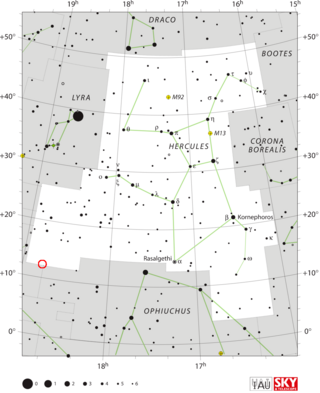
V838 Herculis, also known as Nova Herculis 1991, was a nova which occurred in the constellation Hercules in 1991. It was discovered by George Alcock of Yaxley, Cambridgeshire, England at 4:35 UT on the morning of 25 March 1991. He found it with 10×50 binoculars, and on that morning its apparent visual magnitude was 5. Palomar Sky Survey plates showed that before the outburst, the star was at photographic magnitude 20.6 and 18.25.
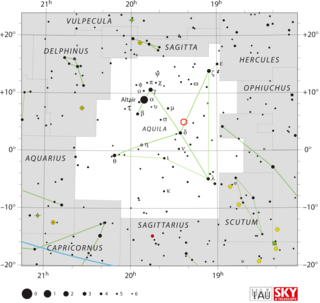
V1494 Aquilae or Nova Aquilae 1999 b was a nova which occurred during 1999 in the constellation Aquila and reached a brightness of magnitude 3.9 on 2 December 1999. making it easily visible to the naked eye. The nova was discovered with 14×100 binoculars by Alfredo Pereira of Cabo da Roca, Portugal at 18:50 UT on 1 December 1999, when it had a visual magnitude of 6.0.
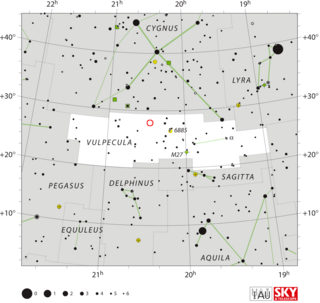
QU Vulpeculae, also known as Nova Vulpeculae 1984 Number 2, was the second nova which occurred in 1984 in the constellation Vulpecula. It was discovered by Peter Collins, an amateur astronomer from Cardiff, California at 22:08 UT on 22 December 1984. At the time of its discovery, the nova's apparent magnitude was 6.8. By the next night, Collins reported its brightness had increased to magnitude 5.6, making it visible to the naked eye.

RW Ursae Minoris is a cataclysmic variable star system that flared up as a nova in the constellation Ursa Minor in 1956.
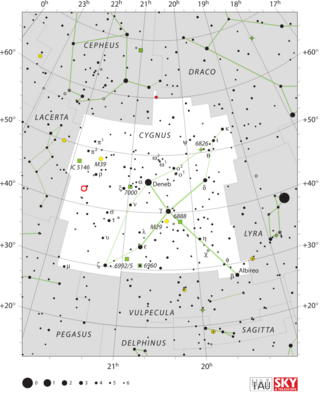
Q Cygni, is a star located in the constellation Cygnus. It is also known as Nova Cygni 1876, and has the designation NGC 7114, and HR 8296. Nova Cygni is located in the northwestern portion of Cygnus along the border with Lacerta.

V630 Sagittarii was a nova visible to the naked eye in 1936. It was discovered on 3 October 1936 by Shigeki Okabayashi of Kobe, Japan when it had an apparent magnitude of 4.5.
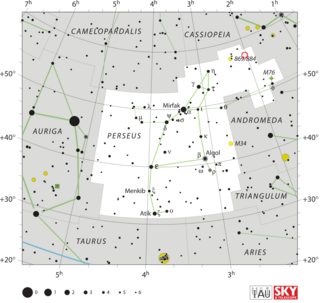
V Persei, also known as Nova Persei 1887 was discovered by Williamina Fleming on a Harvard College Observatory objective-prism photograph taken on 3 November 1887. It is believed to be the first nova whose spectrum was recorded. The nova had an apparent magnitude of 9.2 at the time of discovery. Judging from the consistency of the nova's brightness after discovery, and details of the spectral lines seen, McLaughlin estimated that the nova was five or six months past peak brightness at the time of its discovery, and at its peak it was almost certainly at least as bright as 4th magnitude. So V Persei was probably visible to the naked eye, though there is no record that anyone actually noticed it when that was possible. It is currently an 18th magnitude object.

QZ Aurigae, also known as Nova Aurigae 1964, was a nova which occurred in the constellation Auriga during 1964. It was discovered by Nicholas Sanduleak on an objective prism photographic plate taken at the Warner and Swasey Observatory on 4 November 1964. Examination of pre-discovery plates from Sonneberg Observatory showed that the eruption occurred in early February 1964, and it had a photographic magnitude of 6.0 on 14 February 1964. Its brightness declined in images taken after the 14th, suggesting that its peak brightness was above 6.0. It was probably visible to the naked eye for a short time.
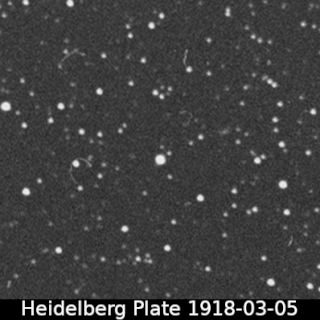
GI Monocerotis, also known as Nova Monocerotis 1918, was a nova that erupted in the constellation Monoceros during 1918. It was discovered by Max Wolf on a photographic plate taken at the Heidelberg Observatory on 4 February 1918. At the time of its discovery, it had a photographic magnitude of 8.5, and had already passed its peak brightness. A search of plates taken at the Harvard College Observatory showed that it had a photographic magnitude of 5.4 on 1 January 1918, so it would have been visible to the naked eye around that time. By March 1918 it had dropped to ninth or tenth magnitude. By November 1920 it was a little fainter than 15th magnitude.

V1370 Aquilae, also known as Nova Aquilae 1982, is a nova that appeared in the constellation Aquila during 1982. It was discovered by Minoru Honda of Kurashiki, Japan at 20:30 UT on 27 January 1982. At that time the Sun had moved just far enough from Aquila to allow the nova to be seen in the morning sky. Although it was discovered photographically, its apparent magnitude was 6–7, making it potentially visible to the naked eye under ideal conditions. A possible magnitude 20 progenitor was located on the Palomar Sky Survey prints. Spectra of the object were taken in February 1982 at Asiago Astrophysical Observatory, which confirmed that it is a nova.

OY Arae, also known as Nova Arae 1910, is a nova in the constellation Ara. It was discovered by Williamina Fleming on a Harvard Observatory photographic plate taken on April 4, 1910. At that time it had a magnitude of 6.0, making it faintly visible to the naked eye under ideal observing conditions. Examination of earlier plates showed that before the outburst it was a magnitude 17.5 object, and by March 19, 1910, it had reached magnitude 12.





















